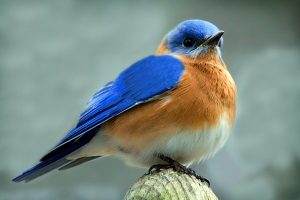By Cliff Chapman
Executive Director, Central Indiana Land Trust
I got a text from a friend a couple days ago asking if I wanted to go look for a saw-whet owl. It was too good of an opportunity for an enthusiastic birder to pass up.
Saw-whets are tiny owls who winter in Indiana. This owl—that nearly no one knows about—is an example of winter migration to somewhere other than the tropics. In this case, Central Indiana offers the warmer climate that birds flock to.
Like many people, my wife and I enjoy watching more common birds fill up at the bird feeders in our backyard (and we are excited about the Great Backyard Bird Count coming up!). It’s pretty obvious to even the casual observer that some birds, like chickadees and white-breasted nuthatches, stay around all year long—while some are just here for the winter, like juncos and white-throated sparrows.
But seeing the same bird species all year can sometimes be deceiving. Most folks don’t realize it, but goldfinches actually migrate. Yes, we have goldfinches year-round in our backyard, but our bright yellow friends from the summer are probably somewhere in Kentucky right now, while the hungry friends crowding our feeders now will fly up to Michigan this spring. Their migration is a much smaller shift than the warblers that will pass through Indiana in May.

Certain year-round birds shift in other ways, using seasonal flocking for protection. We often have bluebirds in our yard in winter—lots of them at the same time. On the other hand, I haven’t seen a robin in our yard in quite a while, but as I was picking up my son at school this week, I spied about 50 of them eating berries from fruit trees in the schoolyard. (Contrary to popular belief, not all robins winter in Florida!) At some point the birds will disperse and find their own territories, but for now, they are staying with their buddies.
This winter flocking tactic makes me wonder if the robins who will soon nest in our yard are right now hanging out in the schoolyard.
I took my friend up on the offer to search for the saw-whet, an owl the size of a soda can. While walking through the (undisclosed) woods,* we were surprised to see a hermit thrush. These are northern birds that I assumed would be well south of us this time of year. The area we were in had lots of shrubs with berries, so the handsome and lonely bird must have figured it made sense to stick around on its way south.
A bit later, we had the thrill of finding the bird we were looking for. And a surprising thing happened while we were looking at this still and somewhat bored-looking saw-whet owl. We heard a blue jay in a nearby tree mimicking its call. This blew me away. Blue jays’ main call mimics a red-shouldered hawk, but here it was making thin whistle notes just like a saw-whet owl!
Nature just never ceases to amaze me.
* Saw-whet locations are kept secret, as these birds’ best defense is to stay still. People have been known to put ladders up near the owl’s perch, and this harassment can have negative impacts.
Want to take part in the Great Backyard Bird Count, Feb. 12-15? This weekend count, sponsored by Cornell Lab of Ornithology, Audubon, and Birds Canada, is a fun way to contribute citizen science to the body of bird knowledge. More than a quarter-million people go out to watch birds at once! Find instructions here.

Cliff Chapman
President and CEO